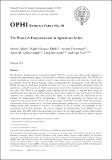| dc.contributor.author | Alkire, Sabina | en |
| dc.contributor.author | Meinzen-Dick, Ruth | en |
| dc.contributor.author | Peterman, Amber | en |
| dc.contributor.author | Quisumbing, Agnes R. | en |
| dc.contributor.author | Seymour, Greg | en |
| dc.contributor.author | Vaz, Ana | en |
| dc.date.accessioned | 2016-06-23T14:39:37Z | |
| dc.date.available | 2016-06-23T14:39:37Z | |
| dc.date.issued | 2013 | en |
| dc.identifier.citation | Alkire, S., Meinzen-Dick, R., Peterman, A., et al. (2013) The Women’s Empowerment in Agriculture Index, OPHI Working Papers 58. Oxford: University of Oxford. | en |
| dc.identifier.isbn | 9781907194450 | |
| dc.identifier.uri | https://opendocs.ids.ac.uk/opendocs/handle/20.500.12413/11815 | |
| dc.description.abstract | The Women’s Empowerment in Agriculture Index (WEAI) is a new survey-based index designed to measure the empowerment, agency, and inclusion of women in the agricultural sector. The WEAI was initially developed as a tool to reflect women’s empowerment that may result from the United States government’s Feed the Future Initiative, which commissioned the development of the WEAI. The WEAI can also be used more generally to assess the state of empowerment and gender parity in agriculture, to identify key areas in which empowerment needs to be strengthened, and to track progress over time. The WEAI is an aggregate index, reported at the country or regional level, based on individual-level data collected by interviewing men and women within the same households. The WEAI comprises two subindexes. The first assesses the degree to which women are empowered in five domains of empowerment (5DE) in agriculture. It reflects the percentage of women who are empowered and, among those who are not, the percentage of domains in which women enjoy adequate achievements. These domains are (1) decisions about agricultural production, (2) access to and decision-making power about productive resources, (3) control of use of income, (4) leadership in the community, and (5) time allocation. The second subindex (the Gender Parity Index [GPI]) measures gender parity. The GPI reflects the percentage of women who are empowered or whose achievements are at least as high as the men in their households. For those households that have not achieved gender parity, the GPI shows the empowerment gap that needs to be closed for women to reach the same level of empowerment as men. This technical paper documents the development of the WEAI and presents pilot data from Bangladesh, Guatemala, and Uganda, so that researchers and practitioners seeking to use the index in their own work would understand how the survey questionnaires were developed and piloted, how the qualitative case studies were undertaken, how the index was constructed, how various indicators were validated, and how it can be used in other settings. | en |
| dc.language.iso | en | en |
| dc.relation.ispartofseries | OPHI Working Papers 58 | en |
| dc.rights.uri | http://creativecommons.org/licenses/by-nc-nd/4.0/ | en |
| dc.title | The Women's Empowerment in Agriculture Index | en |
| dc.type | Series paper (non-IDS) | en |
| dc.rights.holder | Oxford Poverty & Human Development Initiative | |
| dc.identifier.externaluri | https://doi.org/10.35648/20.500.12413/11781/ii033 | |
| dc.identifier.ag | RES-167-25-0617, ES/I032827/1 | en |
| dc.identifier.doi | 10.35648/20.500.12413/11781/ii033 | |


